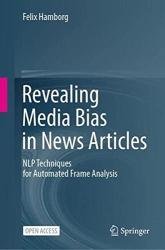Revealing Media Bias in News Articles: NLP Techniques for Automated Frame Analysis
- Добавил: literator
- Дата: 26-02-2023, 09:25
- Комментариев: 0
 Название: Revealing Media Bias in News Articles: NLP Techniques for Automated Frame Analysis
Название: Revealing Media Bias in News Articles: NLP Techniques for Automated Frame AnalysisАвтор: Felix Hamborg
Издательство: Springer
Год: 2023
Страниц: 245
Язык: английский
Формат: pdf (true), epub
Размер: 30.5 MB
This book presents an interdisciplinary approach to reveal biases in English news articles reporting on a given political event. The approach named person-oriented framing analysis identifies the coverage’s different perspectives on the event by assessing how articles portray the persons involved in the event. In contrast to prior automated approaches, the identified frames are more meaningful and substantially present in person-oriented news coverage.
The book is structured in seven chapters: Chapter 1 presents a few of the severe problems caused by slanted news coverage and identifies the research gap that motivated the research described in this thesis. Chapter 2 discusses manual analysis concepts and exemplary studies from the social sciences and automated approaches, mostly from computer science and computational linguistics, to analyze and reveal media bias. This way, it identifies the strengths and weaknesses of current approaches for identifying and revealing media bias. Chapter 3 discusses the solution design space to address the identified research gap and introduces person-oriented framing analysis (PFA), a new approach to identify substantial frames and to reveal slanted news coverage. Chapters 4 and 5 detail target concept analysis and frame identification, the first and second component of PFA. Chapter 5 also introduces the first large-scale dataset and a novel model for target-dependent sentiment classification (TSC) in the news domain. Eventually, Chapter 6 introduces Newsalyze, a prototype system to reveal biases to non-expert news consumers by using the PFA approach. In the end, Chapter 7 summarizes the thesis and discusses the strengths and weaknesses of the thesis to derive ideas for future research on media bias.
Content analysis software, generally also called computer-assisted qualitative data analysis software (CAQDAS), supports analysts when performing content analyses. Most tools support the manual annotation of findings for the analyzed news data or for other types of reports, such as police reports. To reduce the large amount of texts that need to be reviewed, the software helps users find relevant text passages, e.g., by finding documents or text segments containing the words specified in the codebook or from a keyword list so that the coder must review less texts manually. In addition, most software helps users find patterns in the documents, e.g., by analyzing the frequencies of terms, topic, or word co-occurrences.
The three forms of analysis discussed in Sect. 2.2.4 require significant manual effort and expertise, since those analyses require human interpretation of the texts and cannot be fully automated. For example, a quantitative content analysis might (semi-)automatically count words that have previously been manually defined in a codebook, but they would be unable to read for “meaning between the lines,” which is why such methods continue to be considered less comprehensive than a qualitative analysis. However, the recent methodological progress in Natural Language Processing (NLP) in Computer Science promises to help alleviate many of these concerns.
Crawling news websites can be achieved using many web crawling frameworks, such as scrapy for Python. Such frameworks traverse the links of websites, hence need to be tailored to the specific use case. Extracting information from news articles is required to convert the raw data that the crawler retrieves into a format that is suitable for further analysis tasks, such as Natural Language Processing. Information to be extracted typically includes the headline, authors, and main text. These systems typically achieve high precision and recall for their extraction task, but require significant initial setup effort in order to customize the extractors to a set of specific news websites.
The three-phase analysis pipeline preprocesses a news text, finds candidate phrases for each of the 5W1H questions, and scores these. Giveme5W1H can easily be accessed via Python and via a RESTful API. Besides the intended use in PFA, Giveme5W1H can be accessed by other software as a Python library and via a RESTful API. Due to its modularity, researchers can efficiently adapt or replace components. For example, researchers can integrate a custom parser or adapt the scoring functions tailored to the characteristics of their data.
This book mainly targets researchers and graduate students from computer science, computational linguistics, political science, and further social sciences who want to get an overview of the relevant state of the art in the other related disciplines and understand and tackle the issue of bias from a more effective, interdisciplinary viewpoint.
Скачать Revealing Media Bias in News Articles: NLP Techniques for Automated Frame Analysis
[related-news] [/related-news]
Внимание
Уважаемый посетитель, Вы зашли на сайт как незарегистрированный пользователь.
Мы рекомендуем Вам зарегистрироваться либо войти на сайт под своим именем.
Уважаемый посетитель, Вы зашли на сайт как незарегистрированный пользователь.
Мы рекомендуем Вам зарегистрироваться либо войти на сайт под своим именем.
